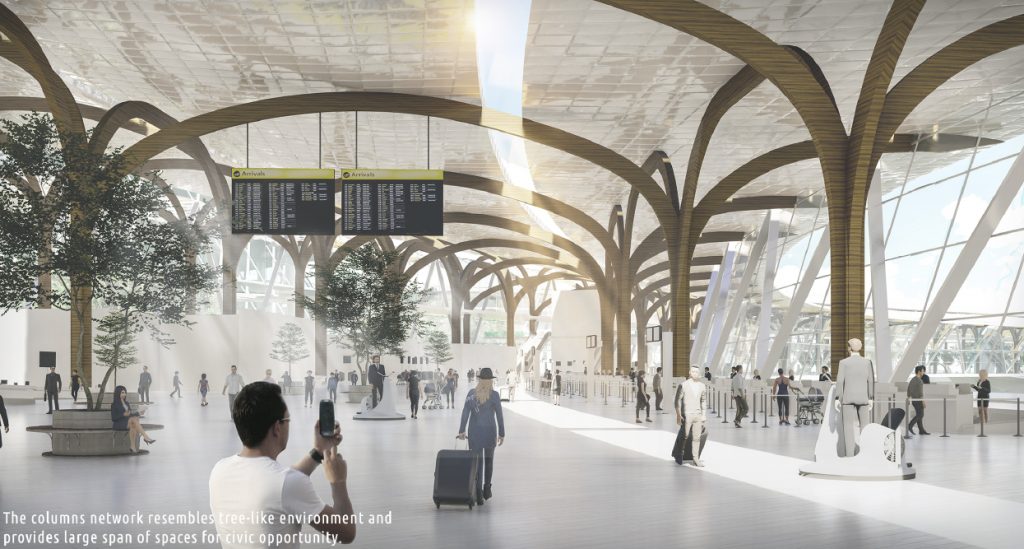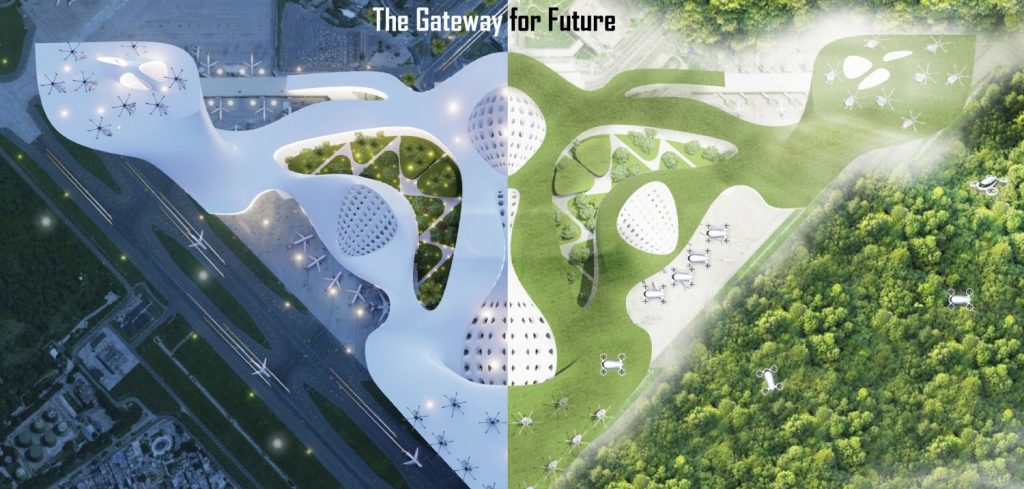The Green Gateway, a zero-emission, highly sustainable multimodal hub, has been named the winner of the 2020 Fentress Global Challenge (FGC), an annual global student design competition run by Fentress Architects.
According to the company, over 100 entries were submitted, from students in more than 15 countries, with this year’s competition challenging participants to envision airport mobility in the year 2100.
“A deep passion for design and a creative mindset are the cornerstone of any successful design competition submission,” said Curtis Fentress, FAIA, RIBA, principal in charge of design at Fentress Architects. “Each year, the submissions we receive are more innovative, spirited and dynamic than the prior year, which shows an exciting outlook for the future of terminal design. We’re greatly impressed by this year’s winners and every submission we received.”
The winning concept, designed by Nikhil Bang and Kaushal Tatiya from the Southern California Institute of Architecture (SCI-Arc), transforms Indira Gandhi International Airport into a forward-thinking, sustainable multimodal hub that mitigates the environmental impacts of air travel while enhancing mobility across New Delhi, India — one of the most populated and polluted cities in the world. The design, dubbed ‘the Green Gateway’ (top), proposes a future where airports are more than buildings; they provide a seamless connection to the cultural context of the site, from their planning to their form and materiality.
Embracing sustainable design strategies, the zero-emission concept features a decentralized system of one central terminal and six towers dispersed throughout the city. The towers provide a dual purpose, working as both air-purifying centers and stations for flying cars. This solution significantly improves mobility across the city by replacing domestic flights as one of the major sources of pollution.
The students’ submission describes the airport’s design as “zero-emission at the macro and micro level, improving mobility across the city by replacing domestic flight as one of the major sources of pollution and making air travel a person affair.”
 Second place was taken by Dušan Sekulic, a student at the University of Ljubljana, Slovenia. Their concept (above) reimagined Hartsfield-Jackson Atlanta International Airport (ATL) — the busiest airport in the world — as a drive-in airport with fully autonomous pods, driving chairs, AI-powered navigation, and vertical take-off and landing (VTOL) aircraft.
Second place was taken by Dušan Sekulic, a student at the University of Ljubljana, Slovenia. Their concept (above) reimagined Hartsfield-Jackson Atlanta International Airport (ATL) — the busiest airport in the world — as a drive-in airport with fully autonomous pods, driving chairs, AI-powered navigation, and vertical take-off and landing (VTOL) aircraft.
 In third place was the Floating Aero City (above), designed by Yuanxiang Chan, Chaofan Zhang, and Zhuangzhuang King from Beijing Jiaotong University, which the judges noted provided a visionary approach to sustainable design. Located in Hong Kong, the airport concept responds to the site’s subtropical climate conditions and high-density issues. Floating on the sea, the airport’s three-dimensional, moveable platform reduces the impact on the natural terrain while increasing available land. The structure’s vertical form significantly reduces the time it takes passengers to flow from check-in to boarding, enhancing the overall passenger experience. Sustainable design strategies include daylighting, tidal power generation, a circular runway and hydrogen-powered aircraft.
In third place was the Floating Aero City (above), designed by Yuanxiang Chan, Chaofan Zhang, and Zhuangzhuang King from Beijing Jiaotong University, which the judges noted provided a visionary approach to sustainable design. Located in Hong Kong, the airport concept responds to the site’s subtropical climate conditions and high-density issues. Floating on the sea, the airport’s three-dimensional, moveable platform reduces the impact on the natural terrain while increasing available land. The structure’s vertical form significantly reduces the time it takes passengers to flow from check-in to boarding, enhancing the overall passenger experience. Sustainable design strategies include daylighting, tidal power generation, a circular runway and hydrogen-powered aircraft.
 The Vertebrae (above), located in Singapore, and designed by Yi Yang Chai and Sharon Cho from the University of Malaya, won the People’s Choice Award with more than 6,200 public votes. The biophilic design harmonizes the built environment with nature to create a “garden city” — a future airport archetype that forms a contextual representation of its culture.
The Vertebrae (above), located in Singapore, and designed by Yi Yang Chai and Sharon Cho from the University of Malaya, won the People’s Choice Award with more than 6,200 public votes. The biophilic design harmonizes the built environment with nature to create a “garden city” — a future airport archetype that forms a contextual representation of its culture.
“This is a beautiful concept with a strong connection to existing structures and attention to the environment,” said Lois Kramer, a 2020 FGC Juror and CEO at Kramer Aerotek inc. “The design is resilient in how it addresses air pollution and possibility of evolving modes of transportation.
 Following in a close second, with over 5,900 public votes, was the O’Pon the Hill Airport concept (above) designed by Ridwan Arifin, Imaduddin Dhia Ul-Fath and Ervin Dwiratno from Yogyakarta University of Technology. The concept blends culture, history and technology to envision the future of O’Hare International Airport with a futuristic terminal featuring a Smart Air Pad to accommodate vertical take-off and landing. Equipped with nanotechnology, the Smart Air Pad examines the performance of aircraft. Additionally, People Mover Pods move passengers throughout the terminal, enhancing circulation and the overall passenger experience.
Following in a close second, with over 5,900 public votes, was the O’Pon the Hill Airport concept (above) designed by Ridwan Arifin, Imaduddin Dhia Ul-Fath and Ervin Dwiratno from Yogyakarta University of Technology. The concept blends culture, history and technology to envision the future of O’Hare International Airport with a futuristic terminal featuring a Smart Air Pad to accommodate vertical take-off and landing. Equipped with nanotechnology, the Smart Air Pad examines the performance of aircraft. Additionally, People Mover Pods move passengers throughout the terminal, enhancing circulation and the overall passenger experience.


